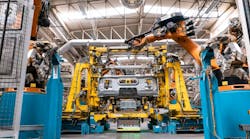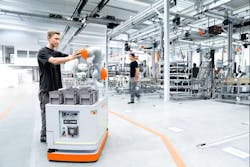What you Need to Know About Mobile Robots
Using people to push carts or drive forklift trucks throughout a production floor or warehouse may not always be the best use of their time, so it is no surprise that mobile robots are on the rise. While many of them will be running in warehouses, plenty will also be used in manufacturing and assembly as constant improvements in sensor technology, safety and flexibility make it easier to implement them in such environments.
Mobile robots have various applications in manufacturing, such as moving raw materials, tools and parts to, from and between the lines. For example, one factory used mobile platforms in an application to transport truck cabins from a storage area to several welding stations. After bringing it to a manual quality-inspection location, the mobile robot then moved it into another storage area.
In addition, different accessories, such as conveyors or robotic arms, can expand the range of applications to machine tending, tool changing, unloading 3D printers, inspection and part processing. Semiconductor manufacturers, for example, use mobile robots with an integrated collaborative robot arm in a clean-room environment to move wafer boxes to different machines and storage areas (see figure).
With the implementation of different mobile robots over the past few years, much has been learned about integrating mobile robots in manufacturing environments with other machinery. Here are a few key considerations to get you started.
First, it’s crucial to consider how manual processes and functions normally handled by humans must be adjusted for machinery or robots. Understanding the processes and tasks that need to change so that a mobile robot can work is an important step.
After understanding and specifying the processes and tasks, finding the right mobile solution is essential. Answering these 5 questions will help:
- What mobile robot fits the size and payload of the load, and how can it be safely loaded, unloaded and secured?
- Can the robot move safely throughout the production floor, and are there other vehicles to consider?
- How precisely does the mobile robot have to drive?
- What machinery does the mobile robot need to interact with?
- How do you ensure people in the area are safe at any step of the process?
Also keep in mind that humans can work with paper instructions, but robots cannot. Consider your data flow and the best software solution for the situation. Find a way for the robots to get their orders—typically, from an overarching software such as a warehouse-management system (WMS) or from a programmable logic controller (PLC). Investigate how best to communicate between the different systems and how to design the human-machine interface. You should also consider if and how you want to handle the prioritization of orders, right-of-way rules and charging situations.
Finally, investments in mobile robots should look beyond short-term gains and include the increase of throughput and savings on personnel. Consider improvements in safety and ergonomics, flexibility and quality, process optimization and traceability. For some factories, the challenges in finding people to work in manufacturing might mean that automation is necessary to continue doing business and attracting new and younger workers.
Denise Stafford is business development manager at Kuka Robotics.
This article appeared in Control Design, an affiliate publication to Machine Design.

